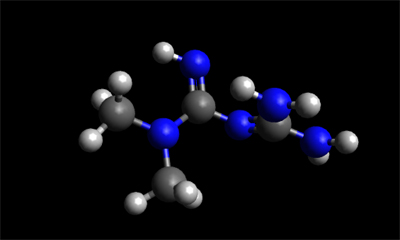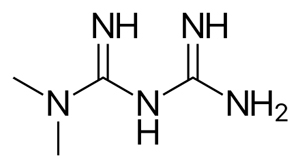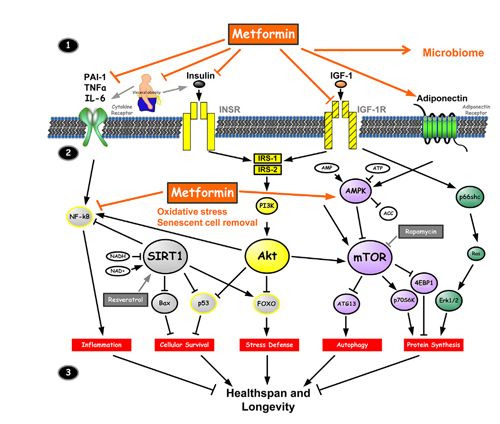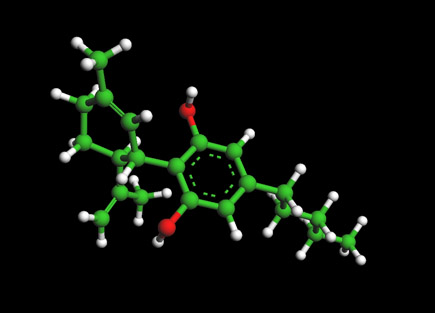Metformin as a Senolytic

Ball and Stick Model for Metformin Molecule
About Metformin
Metformin is the most widely used drugs in the treatment of type 2 diabetes mellitus (T2DM) since it was approved in the United Kingdom in 1958 and in the United States in 1995. The drug is marketed under the trade name Glucophage among others.
Structure

Metformin Molecular Structure
The chemical classification of metformin is Biguanides.
Mechanism of Action for Diabetes
The molecular mechanism of metformin is not completely understood. Multiple potential mechanisms of action have been proposed: inhibition of the mitochondrial respiratory chain (complex I), activation of AMP-activated protein kinase (AMPK), inhibition of glucagon-induced elevation of cyclic adenosine monophosphate (cAMP) with reduced activation of protein kinase A (PKA), inhibition of mitochondrial glycerophosphate dehydrogenase, and an effect on gut microbiota.[85][86][87] Ultimately, it decreases gluconeogenesis (liver glucose production).[73] It also has an insulin-sensitizing effect with multiple actions on tissues including the liver, skeletal muscle, endothelium, adipose tissue, and the ovary.[44][88] The average patient with type 2 diabetes has three times the normal rate of gluconeogenesis; metformin treatment reduces this by over one-third.[89]
METFORMIN FOR ANTI-AGING
Metformin is an FDA-approved first-line drug for the treatment of type 2 diabetes, used successfully for over 60 years with an outstanding safety record. Studies in the biology of aging have shown that metformin can delay aging in animals. These findings point to the likelihood that metformin may influence fundamental aging factors that underlie multiple age-related conditions in humans.
What is the TAME Trial?
Targeting Aging with Metformin (TAME) is a novel clinical trial, that will test whether the drug metformin, a widely-used treatment for type 2 diabetes, can delay the onset of age-related diseases and conditions including cancer, cardiovascular disease and Alzheimer’s disease. See more about TAME trial.
Mechanism of Action as an Anti-Aging Molecule
https://www.ncbi.nlm.nih.gov/pmc/articles/PMC5943638/
Specifically for aging, metformin leads to decreased insulin levels, decreased IGF-1 signaling (Liu et al., 2011), inhibition of mTOR (Kickstein et al., 2010; Nair et al., 2014; Pérez-Revuelta et al., 2014), inhibition of mitochondrial complex 1 in the electron transport chain and reduction of endogenous production of reactive oxygen species (ROS) (Batandier et al., 2006; Bridges et al., 2014; Zheng et al., 2012), activation of AMP-activated kinase (AMPK) (Cho et al., 2015; Duca et al., 2015; Foretz et al., 2010; Lien et al., 2014; Lu et al., 2015; Zheng et al., 2012), and reduction in DNA damage (Algire et al., 2012). Metformin favorably influences metabolic and cellular processes closely associated with the development of age-related conditions, such as inflammation (Saisho, 2015), autophagy (Song et al., 2015; Xie et al., 2011), and cellular senescence (Jadhav et al., 2013; Moiseeva et al., 2013).
Metformin Targets Multiple Pathways of Aging

Shown above a schematic of the current consensus within the biology of aging community as to pathways that are important to target aging and indicates at which points metformin has been shown to have effects (see text of Metformin as a Tool to Target Aging --Barzilai et a. 2016). "...Key take-away: outside of the cell (1, top), metformin has been shown to affect the receptors for cytokines, insulin, IGF-1, and adiponectin, all pathways that are activated with aging and, when modulated, are associated with longevity. (1) Intracellular (2, middle) metformin inhibits the inflammatory pathway and activates AMPK, increasing inhibition of mTOR, which seems to be a major target to modulate aging. Through some of these mechanisms, it also modulates oxidative stress and removes senescent cells (the mitochondrial pathways are not shown, and the mechanisms by which metformin induces senescent cell removal remain unclear). (2) These processes jointly (3, bottom) affect inflammation, cellular survival, stress defense, autophagy, and protein synthesis, which are major biological outcomes associated with aging/longevity..." Originally adapted from Barzilai et al. (2012) -- The Critical Role of Metabolic Pathways in Aging.
Meformin as a double-edged sword
The diabetes drug metformin, sometimes taken to slow aging, may blunt the health benefits of exercise.
18 February, 2019 Metformin inhibits mitochondrial adaptations to aerobic exercise training in older adults.
"...Metformin and exercise independently improve insulin sensitivity and decrease the risk of diabetes. Metformin was also recently proposed as a potential therapy to slow aging. However, recent evidence indicates that adding metformin to exercise antagonizes the exercise-induced improvement in insulin sensitivity and cardiorespiratory fitness. The purpose of this study was to test the hypothesis that metformin diminishes the improvement in insulin sensitivity and cardiorespiratory fitness after aerobic exercise training (AET) by inhibiting skeletal muscle mitochondrial respiration and protein synthesis in older adults (62 ± 1 years). In a double-blinded fashion, participants were randomized to placebo (n = 26) or metformin (n = 27) treatment during 12 weeks of AET. Independent of treatment, AET decreased fat mass, HbA1c, fasting plasma insulin, 24-hr ambulant mean glucose, and glycemic variability. However, metformin attenuated the increase in whole-body insulin sensitivity and VO2 max after AET. In the metformin group, there was no overall change in whole-body insulin sensitivity after AET due to positive and negative responders. Metformin also abrogated the exercise-mediated increase in skeletal muscle mitochondrial respiration. The change in whole-body insulin sensitivity was correlated to the change in mitochondrial respiration. Mitochondrial protein synthesis rates assessed during AET were not different between treatments. The influence of metformin on AET-induced improvements in physiological function was highly variable and associated with the effect of metformin on the mitochondria. These data suggest that prior to prescribing metformin to slow aging, additional studies are needed to understand the mechanisms that elicit positive and negative responses to metformin with and without exercise..."
"...In effect, metformin had road-blocked the normal exercise-related gains in muscle-cell mitochondrial respiration, says Benjamin Miller, a principal investigator in the aging and metabolism research program at the Oklahoma Medical Research Foundation, who oversaw the study..." see NYTimes Article on Metformin.
SENOLYTIC AND ANTI-AGING MOLECULES
RAPAMYCIN ---The mechanistic target of rapamycin (mTOR) pathway has a central role in cell activation...
METFORMIN -- The diabetes drug metformin used by some for anti-aging may diminish benefits of aerobic exercise...
QUERCETIN-- AND WITH DASATINIB--The senolytic cocktail, dasatinib plus quercetin, which causes selective elimination of senescent cells...
FISETIN--Of the 10 flavonoids tested, fisetin was the most potent senolytic...
EGCG- The most active component of green tea....
NAD BOOSTERS --'...The cells of the old mice were indistinguishable from the young mice, after just one week of treatment...
SULFORAPHANE-- An isothiocyanate present in cruciferous vegetables activates antioxidant and anti-inflammatory responses by ...
UROLITHIN --Metabolite of Pomegranate compound with anti-aging effects passes human trial...
MITO-Q -- A water soluble fomr of CoQ10 that has excellent absorption and high bioavailability...
HONOKIOL - A bioactive natural product derived from Magnolia Bark have demonstrated ...
CURCUMIN AND ANALOGS -Recent research is focused on the design and synthesis of curcumin analogs as antiproliferative and anti-inflammatory agents...
BERBERINE --berberine has recently been reported to expand life span in Drosophila melanogaster, and attenuate premature cellular senescence
N-ACETYL-CYSTINE (NAC)--"...pretreatment with NAC increased glutathione levels in the older cells and largely helped offset that level of cell death..."
PIPERLONGUMINE - A natural product from the Long pepper with high bioavailability...
RESVERATROL AND PTEROTSILBINE -- Pterostilben chemically similar to resveratrol bute differs from resveratrol by exhibiting increased bioavailability (80% compared to 20% in resveratrol)
SPERMIDINE--Spermidine delays aging in humans ...
ALLICIN -- Allicin is a compound produced when garlic is crushed or chopped. ...
VITAMIN D3 -- Production of the active forms of Vitamin D are reduced by 50% as a result of an age-related decline
VITAMIN K-- evidence suggests vitamin K has an anti-inflammatory action
TOCOTRIENOL(AND WITH QUERCETIN) --Tocotrieniols have been found to exert a synergistic antitumor effect on cancer cells when given in combination....
HSP-90 INHIBITORS --As a novel class of senolytics
World of Molecules Resources
The Cannabidiol Molecule
Cannabidiol (CBD is the major non-psychoactive component of Cannabis and is being looked at by major drug and consumer companies for various medical and social uses.